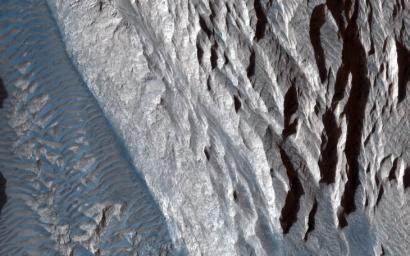
|
Sandstone Cliffs and Hematite Lag Deposits of Ophir Mensa
- Click the image above for a larger view
- Full-Res JPEG (2880 x 1800) (750.2 kB)
- Full-Res TIFF (2880 x 1800) (15.6 MB)
Caption:
This target was one of the first close HiRISE views of the enigmatic Valles Marineris interior layered deposits. These light-toned sedimentary deposits are of interest to scientists because they are partially composed of minerals like hematite that likely formed in the presence of liquid water.
The lighter-tone linear units to the north are called "yardangs" and formed when downslope winds carved the fragile sandstone into channels. Over time, wind and gravity conspire to erode material downslope and onto the canyon floor. The darker-toned sandy deposits at the cliff base contain high concentrations of hematite s (along with basaltic or volcanic sand) known from infrared orbital measurements.
HiRISE resolution can clearly show outcrops mass wasting finer materials out, and darker layers that are likely hematite-bearing units . This is an excellent candidate for what's called a "hematite lag deposit," where more resistant iron-rich hematite concretions have weathered out of the brittle mesa driven by gravity and wind, similar to that observed at the Mars Exploration Rover Opportunity landing site.
Background Info:
HiRISE is one of six instruments on NASA's Mars Reconnaissance Orbiter. The University of Arizona, Tucson, operates the orbiter's HiRISE camera, which was built by Ball Aerospace & Technologies Corp., Boulder, Colo. NASA's Jet Propulsion Laboratory, a division of the California Institute of Technology in Pasadena, manages the Mars Reconnaissance Orbiter Project for the NASA Science Mission Directorate, Washington.
Cataloging Keywords:
| Name | Value | Additional Values |
|---|---|---|
| Target | Mars | |
| System | ||
| Target Type | Planet | |
| Mission | Mars Reconnaissance Orbiter (MRO) | Mariner, Mars Exploration Rover (MER) |
| Instrument Host | Mars Reconnaissance Orbiter | Opportunity (MER-B) |
| Host Type | Orbiter | Flyby Spacecraft, Rover |
| Instrument | High Resolution Imaging Science Experiment (HiRISE) | |
| Detector | ||
| Extra Keywords | Color, Infrared, Volcano, Water | |
| Acquisition Date | ||
| Release Date | 2013-11-13 | |
| Date in Caption | ||
| Image Credit | NASA/JPL-Caltech/Univ. of Arizona | |
| Source | photojournal.jpl.nasa.gov/catalog/PIA17691 | |
| Identifier | PIA17691 | |
